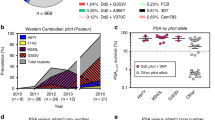Abstract
THE lethal form of human malaria caused by Plasmodium falciparum is virtually uncontrollable in many areas because of the development of drug resistance, in particular chloroquine resistance (CQR). CQR is biologically similar to the multiple drug resistance phenotype (MDR) of mammalian tumour cells, as both involve expulsion of drug from the cell and both can be reversed by calcium channel antagonists1. A homologue (pfmdr1) of the mammalian multidrug resistance gene has been implicated in CQR because it is amplified in some CQR isolates of P. falciparum2,3 as is an mdr gene in MDR tumour cells4. We show here that the complete sequences of pfmdr1 genes from 2 CQ sensitive (CQS) P. falciparum isolates are identical. In 5 CQR isolates, 1–4 key nucleotide differences resulted in amino acid substitutions. On the basis of these substitutions, we have correctly predicted the CQS/CQR status of a further 34 out of 36 isolates. This is a paradox as CQR arises much less frequently than would be predicted if single point mutations were sufficient. We conclude that a mutated pfmdr1 gene is one of at least two mutated genes required for CQR.
Similar content being viewed by others
References
Krogstad, D. J. et al. Science 238, 1283–1285 (1987).
Foote, S. J., Thompson, J. K., Cowman, A. F. & Kemp, D. J. Cell 57, 921–930 (1989).
Wilson, C. M. et al. Science 244, 1184–1186 (1989).
Riordan, J. R. et al. Nature 316, 817–819 (1985).
Saiki, R. K. et al. Science 239, 487–491 (1988).
Choi, K. H., Che, C. J., Kriegler, M. & Roninson, I. B. Cell 53, 519–529 (1988).
Harinasuta T., Migasen, S. & Boonag, D. UNESCO First Regional Symposium on Scientific Knowledge of Tropical Parasites. 148–153 (University of Singapore, Singapore, 1962).
Maberti, S. Arch. Venez. Medic. Trop. Parasitol. Med. 3, 239–259 (1960).
Cowman, A. F. et al. Proc. natn. Acad. Sci. U.S.A. 85, 9109–9113 (1988).
Peterson, D., Walliker, D. & Wellems, T. Proc. natn. Acad. Sci. U.S.A. 85, 9114–9118 (1988).
Wellems, T. E. et al. Nature 345, 253–255 (1990).
Rosario, V. E. Nature 261, 585–586 (1976).
Padua, R. A. Exp. Parastiol. 52, 419–426 (1981).
Cowman, A. F. & Foote, S. J. Int. J. Parasitol. (in the press).
Winship, P. R. Nucleic Acids Res. 17, 1266 (1989).
Peters, W. in Chemotherapy and Drug Resistance (ed. Peters, W.) 1–876 (Academic, London, 1987).
Author information
Authors and Affiliations
Rights and permissions
About this article
Cite this article
Foote, S., Kyle, D., Martin, R. et al. Several alleles of the multidrug-resistance gene are closely linked to chloroquine resistance in Plasmodium falciparum. Nature 345, 255–258 (1990). https://doi.org/10.1038/345255a0
Received:
Accepted:
Issue Date:
DOI: https://doi.org/10.1038/345255a0
- Springer Nature Limited
This article is cited by
-
Multiple pathways for glucose phosphate transport and utilization support growth of Cryptosporidium parvum
Nature Communications (2024)
-
Drug resistance of Plasmodium falciparum and Plasmodium vivax isolates in Indonesia
Malaria Journal (2022)
-
Drug resistance and population structure of Plasmodium falciparum and Plasmodium vivax in the Peruvian Amazon
Scientific Reports (2022)
-
Increase in the proportion of Plasmodium falciparum with kelch13 C580Y mutation and decline in pfcrt and pfmdr1 mutant alleles in Papua New Guinea
Malaria Journal (2021)
-
Plasmodium falciparum phenotypic and genotypic resistance profile during the emergence of Piperaquine resistance in Northeastern Thailand
Scientific Reports (2021)





